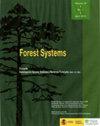Biomass equations for rockrose (Cistus laurifolius L.) shrublands in North-central Spain
IF 0.7
4区 农林科学
Q3 FORESTRY
引用次数: 1
Abstract
Aims of the study: To construct biomass weight equations for rockrose (Cistus laurifolius L.) shrublands in North-central Spain comparing different methodologies and evaluating the applicability of the current Spanish open PNOA-LiDAR data. Area of study: The growing extension of Mediterranean shrublands associated with a high wildfire risk in a climate change scenario is considered a relevant source of biomass for energy use and bioproducts. Quantifying the biomass load of the shrublands provides essential information for adequate management, calling for the development of equations to estimate said biomass loads in the most extensive monospecific shrublands. Materials and methods: Biomass dry weight from 290 destructive sampling plots (ø4m) and 426 individual plants along with LiDAR data from PNOA were related to dasometric parameters to fit weight per surface and weight per plant equations. Main results: Three new equations improve rockrose biomass estimations in North-central Spain: a) Weight per unit area (tDM.ha-1) equation (Eq. 1) based on apparent biovolume (product of crown cover in percentage by average height in meters) (Radj2 0.69, MAE 26.1%, RMSE 38.4%); b) Weight per plant (kgDM.plant-1) equation (Eq. 2) from height and crown diameter (Radj2 0.87, MAE 26.5%, RMSE 45.2%) and c) Weight per unit area equation (tDM.ha-1) (Eq. 3) based on LiDAR data contrasted with field data (Radj2 0.89, MAE 15.1%, RMSE 22.9%). Research highlights: Eq. 1 and Eq. 3 combined with high resolution LiDAR information offer rockrose (Cistus laurifolius L.) biomass estimations without added field work costs that are an improvement on certain more general studies carried out in other areas of Spain.西班牙中北部岩蔷薇(Cistus laurifolius L.)灌木林的生物量方程
研究目的:构建西班牙中北部岩玫瑰(Cistus laurifolius L.)灌木林的生物量重量方程,比较不同的方法,并评估当前西班牙开放PNOA激光雷达数据的适用性。研究领域:在气候变化的情况下,与高野火风险相关的地中海灌木林的不断扩展被认为是能源使用和生物产品的相关生物质来源。量化灌木林的生物量负荷为充分管理提供了必要的信息,要求开发方程来估计最广泛的单一物种灌木林中的生物量负载。材料和方法:来自290个破坏性采样点(ø4m)和426个单株的生物量干重,以及来自PNOA的激光雷达数据,与拟合每表面重量和每株重量方程的计量参数相关。主要结果:三个新的方程改进了西班牙中北部的岩玫瑰生物量估计:a)基于表观生物量(树冠覆盖百分比与平均高度的乘积,单位米)的单位面积重量(tDM.ha-1)方程(Eq.1)(Radj2 0.69,MAE 26.1%,RMSE 38.4%);b) 单株重量(kgDM.plant-1)方程(Eq.2)来自高度和冠径(Radj2 0.87,MAE 26.5%,RMSE 45.2%)和c)单位面积重量方程(tDM.ha-1)(Eq.3)基于激光雷达数据与现场数据(Radj20.89,MAE 15.1%,RMSE22.9%)进行对比。研究重点:Eq.1和Eq.3与高分辨率激光雷达信息相结合,提供了岩蔷薇(Cistus laurifolius L.)的生物量在没有增加实地工作成本的情况下进行的估计,这是对西班牙其他地区进行的某些更一般性研究的改进。
本文章由计算机程序翻译,如有差异,请以英文原文为准。
求助全文
约1分钟内获得全文
求助全文
来源期刊

Forest Systems
FORESTRY-
CiteScore
1.40
自引率
14.30%
发文量
30
审稿时长
6-12 weeks
期刊介绍:
Forest Systems is an international peer-reviewed journal. The main aim of Forest Systems is to integrate multidisciplinary research with forest management in complex systems with different social and ecological background
 求助内容:
求助内容: 应助结果提醒方式:
应助结果提醒方式:


